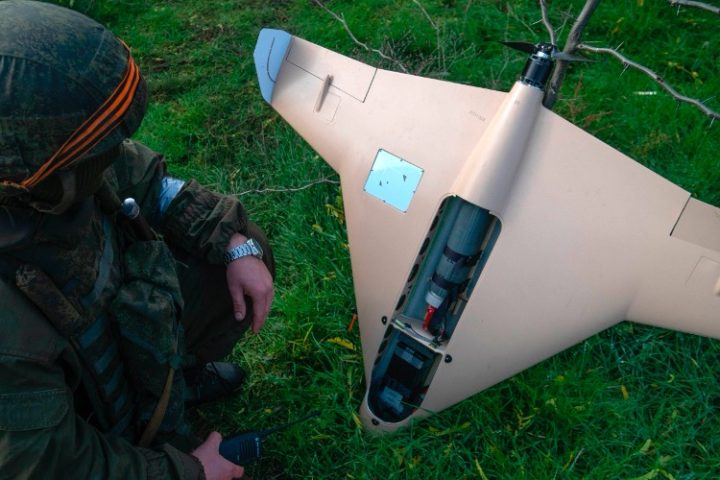
Given that the rate of technological advancement is accelerating, it’s no surprise that states find themselves playing catchup in adapting to the use of novel military technologies. What today is a breakthrough way of fighting could become yesterday’s war within mere months.
This is potentially the case with drone warfare. Recent conflicts, including the Russia-Ukraine war and the attacks by Iran-backed Houthi militias on Western vessels in the Red Sea, have been notable for their extensive and effective use of drones, both for reconnaissance and attack — with explosive-strapped drones becoming a cheap alternative to missiles that cash-strapped actors such as the Houthis are more than happy to leverage.
But while the last few years have seen drones rapidly rise as an essential component in modern warfare, new technologies already in development show potential for neutralizing drone power.
The Yemen-based Houthi rebels started drone strikes last year in protest against Israel’s actions in Gaza. Subsequently, the Houthi drone strikes disrupted shipping in the Red Sea, leading the United States and the U.K. to respond with attacks on Houthi targets this month.
These aggressions have raised concerns and triggered heightened reactions from the United States, highlighting the potential for increased drone attacks globally, with military experts speculating that drones will play an increasingly pivotal role in future wars and be used by terrorists.
While the Houthis’ drone use has recently drawn major media attention, their employment of this tactic is not new. For almost 10 years, they have been at the vanguard when it comes to the use of low-cost drones, frequently with significant assistance from Iran, to engage better funded and better-equipped adversaries.
The Houthis, in fact, declared 2019 “the year of the drones,” according to the Yemen-based think tank known as Sana’a Center for Strategic Studies.
Back in 2015, the Houthis began their use of drones by using them to attack Saudi forces intervening in the Yemeni civil war, per former CIA analyst and Brookings Institution fellow Bruce Riedel, who spoke to NBC News.
As the outlet noted:
The Houthis use drones as if they were missiles, crashing them into targets to cause explosions, according to U.N. investigators and other experts. They use fixed-wing drones that have ranges of hundreds of miles, and they often attach explosive payloads for more impact.
A different group of Iranian-backed militants used a similar tactic Sunday in Jordan, U.S. officials said. Those militants crashed a drone packed with explosives into a U.S. base in northeast Jordan known as Tower 22, killing three U.S. troops and injuring more than 30 others.
… The Houthis’ most damaging use of drones may have occurred in September 2019, when they claimed responsibility for attacks on two of the world’s largest oil processing facilities, the Abqaiq and Khurais complexes in Saudi Arabia. The attacks used 25 drones and missiles to start fires, melt pipes and knock out 5% of the global oil supply, sending oil prices spiking by 20%.
Drones have also played an important role in Ukraine, where both sides are making use of the technology for intelligence acquisition and swift strikes against key targets. As The New American reported, Ukraine last month launched several drone attacks against strategic industries such as oil refineries.
According to reports, drones in some instances caused a standstill in Ukraine not unlike the trench warfare in World War I, when militaries, confounded by the capabilities of modern firearms, found themselves unable to advance in the face of machine guns and artillery.
One recent conflict that fully demonstrates the modern importance of drones, but which has garnered little mainstream media attention, is the Second Nagorno-Karabakh War in 2020, which involved Azerbaijan, Armenia, and the self-declared Armenian breakaway state of Artsakh.
War erupted due to long-standing ethnic and territorial tensions between Azerbaijan and Armenia over the Nagorno-Karabakh region. Nagorno-Karabakh, an enclave predominantly inhabited by ethnic Armenians, is internationally recognized as part of Azerbaijan but has been under the de facto control of ethnic Armenians since the early 1990s.
Azerbaijan sought to regain control over the territory, viewing it as an integral part of its sovereign territory. Armenia, in turn, supported the self-proclaimed Republic of Artsakh (Nagorno-Karabakh) and its right to self-determination.
During the war, Azerbaijan extensively employed Turkish-made Bayraktar TB2 drones, known for their precision strikes and reconnaissance capabilities. These drones played a crucial role in destroying Armenian armored vehicles, artillery units, and air defenses, severely impacting Armenia’s military capabilities. The open terrain of Nagorno-Karabakh favored drone operations, giving Azerbaijan an aerial advantage and strategic control.
Armenia, meanwhile, had limited drone capabilities and relied on older, less effective models, leaving them vulnerable to drone attacks. The war ended favorably for Azerbaijan, which made several territorial gains.
But drones could be neutralized by new technology that is currently being pioneered by the U.K. Defence Ministry. As Defense News reports:
An industry team has for the first time destroyed an aerial target using a high-power shot with its DragonFire laser, the British Defence Ministry announced Friday. The trial with the direct-energy weapon is considered a significant milestone toward the deployment of the system, possibly within five years. Efforts to quickly field such weapons are partly driven by conflicts in Ukraine and near the Red Sea, where expensive air defense missiles are used against cheap but effective drones. The cost of operating the laser is typically less than £10 (U.S. $13) per shot, the ministry noted.
But even this development could play into the hands of non-state actors or nations with small military budgets, allowing them to cheaply put together vehicle-mounted laser platforms to create a cost-effective defense against drone attacks.




